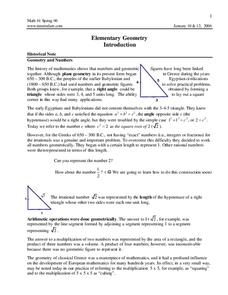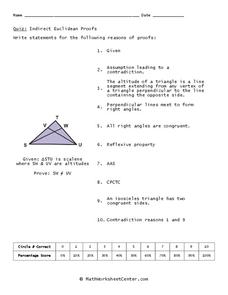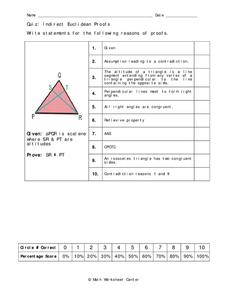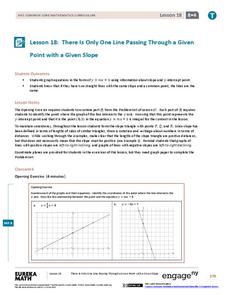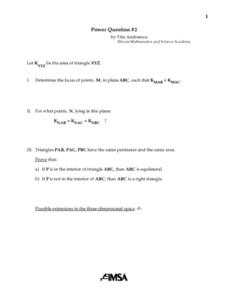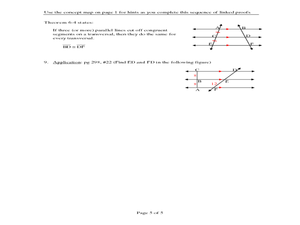Inside Mathematics
Rhombuses
Just what does it take to show two rhombuses are similar? The assessment task asks pupils to develop an argument to show that given quadrilaterals are rhombuses. Class members also use their knowledge of similar triangles to show two...
Mt. San Antonio Collage
Elementary Geometry
Your class may believe that geometry is a trial, but they don't know how right they are. A thorough math lesson combines the laws of logic with the laws of geometry. As high schoolers review the work of historical mathematicians and...
Curated OER
Indirect Euclidean Proofs
In this Euclidean proofs activity, 10th graders solve 10 different problems that include completing indirect Euclidean proofs. First, they write a statement for each of the reasons listed on the sheet of proofs. Then, students solve the...
Curated OER
Indirect Euclidean Proofs
For this indirect Euclidean proof worksheet, students write statements supporting the reasons for a given proof. This one-page worksheet contains ten problems.
Curated OER
Pythagorean Theorem
In this Pythagorean Theorem worksheet, 10th graders solve and complete 19 various types of problems. First, they draw the square shown and divide its sections as shown. Then, students cut out the 6 parts of the square and rearrange the 4...
EngageNY
Ptolemy's Theorem
Everyone's heard of Pythagoras, but who's Ptolemy? Learners test Ptolemy's Theorem using a specific cyclic quadrilateral and a ruler in the 22nd installment of a 23-part module. They then work through a proof of the theorem.
EngageNY
There is Only One Line Passing Through a Given Point with a Given Slope
Prove that an equation in slope-intercept form names only one line. At the beginning, the teacher leads the class through a proof that there is only one line passing through a given point with a given slope using contradiction. The 19th...
Curated OER
Pythagorean Theorem
In this finding the missing units in triangles worksheet, students apply the Pythagorean Theorem to solve. Students solve 10 problems.
Curated OER
Extending Trigonometry Skills
In this trigonometry worksheet, students use the sine and cosine law to solve problems. They investigate obtuse triangles using these laws. There are 40 questions.
Curated OER
Why do Stars Rise in the East?
In this stars rise in the east worksheet, students use geometry to show how the Earth rotates from west to east and why celestial bodies appear to rise in the east and set in the west. Students draw a figure and label given points in...
Curated OER
Power Question 2
In this math worksheet, pupils determine the locus of points, M, in plane ABC, such that KMAB=KMAC. They also draw the triangle ABC. Then determine the proof of the interior angles determining the identity of the equilateral triangle.
EngageNY
Law of Cosines
Build upon the Pythagorean Theorem with the Law of Cosines. The 10th part of a 16-part series introduces the Law of Cosines. Class members use the the geometric representation of the Pythagorean Theorem to develop a proof of the Law of...
Curated OER
Transformations and Congruence
In this transformations and congruence worksheet, 10th graders solve and complete 5 different types of problems. First, they calculate the length of a line giving their answer in 3 significant figures. Then, students prove that two...
EngageNY
Criterion for Perpendicularity
The Pythagorean Theorem is a geometry pupil's best friend! Learners explain the equation a1b1 + a2b2 = 0 for perpendicular segments using the Pythagorean Theorem. They are able to identify perpendicular segments using their...
Charleston School District
Review Unit 8: Geometry Applicaitons
Pupils complete a review activity that highlights the key problems from the first eight lessons in the series. Topics include the Pythagorean Theorem and its converse, as well as finding volume of three-dimensional figures.
Curated OER
Logical Relationship of Postulates & Theorems
In this postulates and theorems instructional activity, students explore a concept map containing information about angles and sides, alternate interior angles, and diagonals of a parallelogram. They use the concept map to prove...



